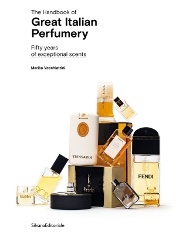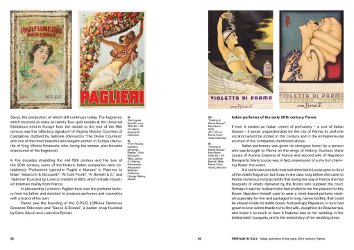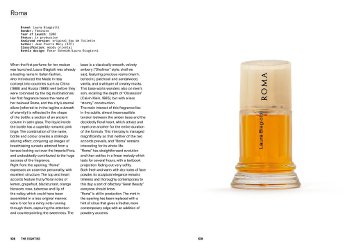
Hey Santa, looking for something to tuck into the sleigh for perfume lovers? Check out The Handbook of Great Italian Perfumery: Fifty years of exceptional scents by Marika Vecchiattini.
The Handbook of Great Italian Perfumery is a combination encyclopedia and compendium of reviews featuring fragrances from Italian perfume houses and fashion brands from the 1970s to the present. It’s both an engrossing read and a handy reference manual.
The book is divided roughly into three parts: background and history of Italian perfumery; reviews of one hundred iconic Italian perfumes, by decade; and a comprehensive index of Italian perfumes launched between 1970 and 2020.

The Handbook’s first section introduces what sets Italian perfumery apart from other fragrance; offers a short history; and — this part comes after the perfume reviews — presents interviews with Italians involved in various aspects of perfume, from creation to production.
What interested me most here was the discussion of what makes a perfume “Italian” — even those fragrances designed by French noses. Vecchiattini posits that sensuality, complexity, and conviviality are the hallmarks of Italian perfume. Unlike the French, Italians, she suggests, value sensual appreciation over cerebral construction, and their centuries-old culture of art and community leads them to create perfume that is lush and friendly, but still complex.

The heart of The Handbook is Vecchiattini’s presentation of one hundred Italian fragrances, each with a full-page review and a photo. Many of the fragrances are no longer in production, but most, like Fendi Theorama and Gucci L’Arte di Gucci, will be familiar to longtime perfume aficionados. Each perfume’s description is lovingly and skillfully written, and on reading them I was drawn to my perfume cabinet more than once to dig for neglected samples.
At the back of the volume is a list of every fragrance released commercially in Italy over the past fifty years. I tested the list here and there (Sinfonia di Note Poudre d’Epices? Check. Mariella Burani? Check.) This must have been a hair-pulling undertaking, and it's fascinating to see how many fragrances fashion houses have released in the past ten years. The "spaghetti" marketing tactic — throw it on the department store perfume counter and see if it sticks — shows itself.
Following this list is a timeline marking years across the horizontal axis and types of fragrance from Oriental/Amber to Marine/Ozonic on the vertical axis. Feminine fragrances are above the horizontal axis and masculines below. Tracked on the timeline are the hundred fragrances featured in The Handbook. What fascinated me about the timeline was noting how different sorts of fragrances rose to popularity at different times. For instance, the late 1980s saw a wave of oriental fragrances, while chypres dominated the early 1980s.
The book is fat, but not coffee table-sized — it’s more the size of a textbook. Its cover is rigid, but not hardbound. The Handbook of Great Italian Perfumery: Fifty years of exceptional scents by Marika Vecchiattini is published by SilvanaEditoriale and costs $45.
Oh, I adore Italian fragrances, they just ‘speak’ to me and wear beautifully on my skin. This book sounds wonderful! And I can’t wait to read about my favorite houses, Fendi and Gucci. I may bypass Santa and purchase this for myself!
Reading this book got me excited to dig out the Italian fragrances I could find in my perfume cabinet!
I bet it did! My aunt wears Mariella Burani – it smells beautiful on her. I can’t wait to read their take on it.
I’m craving a spritz of the original Fendi about now….
I gave myself a spritz, it’s perfect, as always!
Right, so the French don’t value sensual appreciation. Now that is interesting. I’m sure it’s a lovely book, but that comment made me Raider my eyebrows just a tad. 🙂
The French are too intellectual, see? (I know, I know!)
Yes, got that chauvinistic rivalry comment. LOL.
I wonder what a book about English perfumery would have said?
Actually, I fully agree with the idea that the French are more cerebral and the Italians are more passionate. This is reflected very clearly in their respective cuisines and most especially in their music. Think of a typical Italian opera vs. a French opera. I’ve never lived in Italy, and I know that this means I can’t give a fully unbiased comparison, but in every facet of both cultures that I have studied or experienced, this comparison seems to hold pretty true.
I agree!
It’s time for you to write an essay on passion in Italian versus French perfumes! I’d love to read it.
What a beautiful book
I don’t have much Italian perfumes, I think Omnia and ..maybe one more.
Let me know if there is anything I am missing out on Jessica !
Hi, it’s Angela who wrote this! (I know, I’ve been away for a while.) Italy has so many wonderful perfumes….
Aww! Sorry , about the name mistake.
Yes, do tell which are you favorite sensual Italian perfumes
I love the old Fendis, but they’re discontinued. Lorenzo Villoresi is always worth checking out!
What a find, Angela! I’m also a fan of Italian perfumes. Thanks so much for reviewing this book!